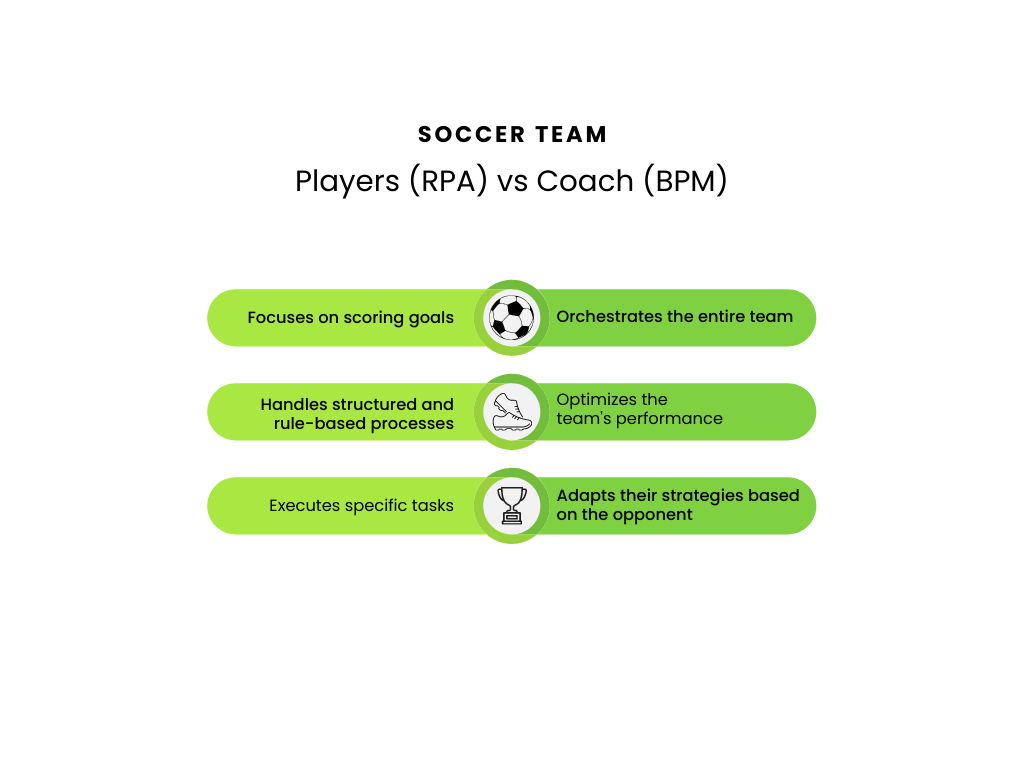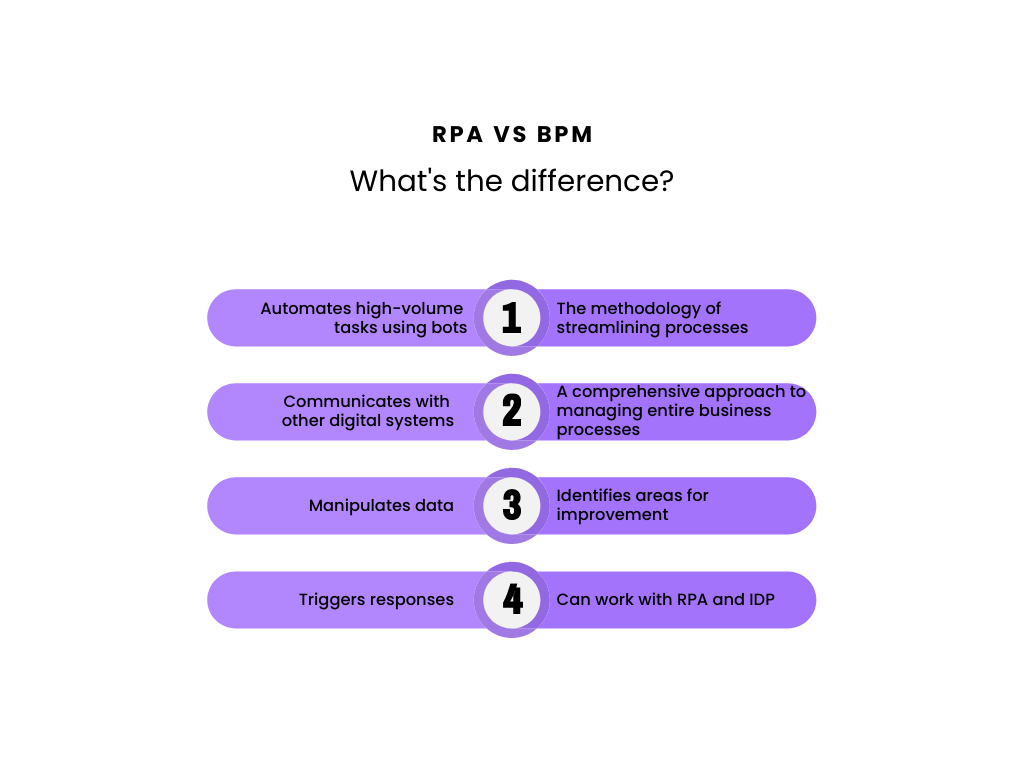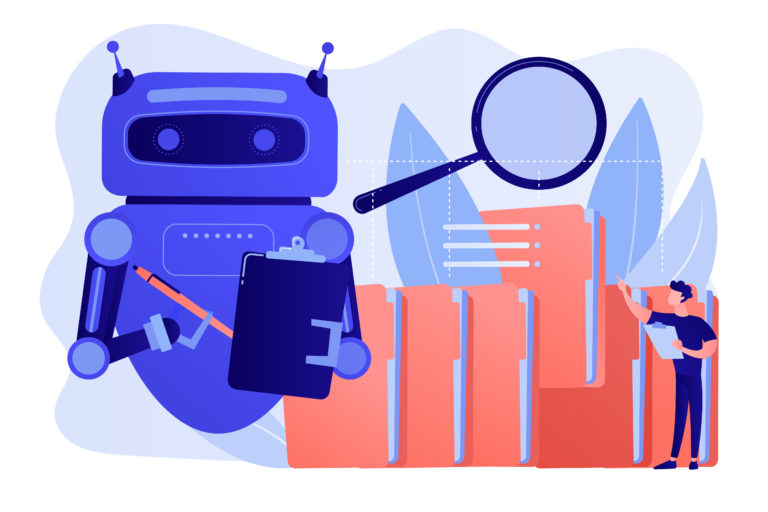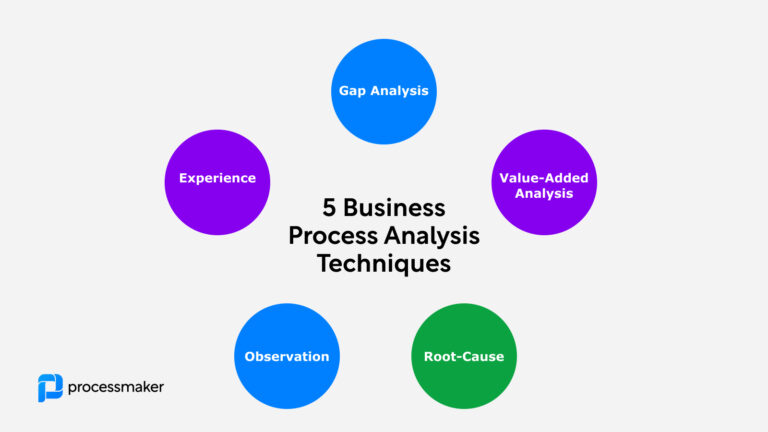What’s the difference between robotic process automation (RPA) and business process management (BPM)? Think of the two concepts as contrasting roles on a sports team; RPA is the individual players, and BPM is a seasoned coach.
But before we jump into the analogies, let’s cover the basics. In this article, we’ll discuss:
- The definition of robotic process automation (RPA)
- The definition of business process management (BPM)
- The difference between robotic process automation (RPA) and business process management (BPM)
- The definition of intelligent document processing (IDP)?
- The difference between intelligent document processing (IDP) and robotic process automation (RPA)
What is RPA?
Let’s start with Robotic Process Automation (RPA), defined by CIO.com as: “an application of technology, governed by business logic and structured inputs, aimed at automating business processes. Using RPA tools, a company can configure software, or a ‘bot’ to capture and interpret applications for processing a transaction, manipulating data, triggering responses, and communicating with other digital systems.” The focus of RPA is the automation of high-volume tasks using bots. This is a much narrower focus than that of business process management, yet an effective technology nonetheless.
RPA is a player on the field; a specialized athlete who can execute specific tasks with precision and speed. Just like a striker in soccer, RPA focuses on scoring goals (automating repetitive tasks) efficiently. It excels at handling structured and rule-based processes, leaving no room for error. When you need to streamline repetitive operations, RPA steps up to the plate, showcasing its remarkable skill set like a true MVP.
What is BPM?
UiPath defines Business Process Management (BPM) as: “an approach to streamlining business processes for maximum efficiency and value. It is an in-depth look at how processes are operating. BPM does this by identifying areas for improvement, and building solutions—usually from the ground up. BPM is about making sure the infrastructure of your business processes is solid.” Therefore, the focus of BPM is broader, a comprehensive approach to managing entire business processes from end-to-end. Businesses do not need to make the decision between RPA or BPM as RPA can complement BPM quite well.

BPM is a strategic coach, guiding the entire team to victory. Like an experienced mentor, BPM takes a holistic view of the game (business processes) and brings a collaborative approach. Just as a coach analyzes the team’s performance, identifies weak spots, and develops winning strategies, BPM maps, analyzes and optimizes the entire process landscape. It ensures that all players (departments and stakeholders) work harmoniously, maximizing efficiency, and achieving long-term success.
So, where’s the confusion?
A common misconception is that RPA and BPM are one and the same. Many people believe that RPA automates processes end-to-end like robust BPM software currently does. If you were paying attention to the definitions of RPA and BPM above, you know that RPA is a technology and BPM is a discipline. The two are in separate categories and have different capabilities.
RPA vs BPM
Every business is ultimately the sum of the tasks, events, and decisions that add up to entire business processes. In the world of workflow automation, BPM is a holistic approach to optimize and automate business processes from the beginning of the game to the end. On the other hand, RPA is a technology that deals with smaller, repetitive tasks completed by bots that just comprise a part of a business process. BPM is an end-to-end solution for automating entire business processes and RPA is a compliment to a solid BPM approach. RPA certainly cannot replace BPM, even if they sometimes reap the same benefits like reducing human error and improving efficiency by automating high-volume, low-value yet repetitive tasks.
RPA solutions empower non-technical users to create “bots” to automate rules-driven business processes. These bots can mimic human activities such as logging into IT systems and copying and pasting data across systems. RPA also requires minimum integration with any existing IT stack. Organizations performing high-volume, transactional processes can potentially boost productivity and save time and money with RPA. But there are better, more efficient technologies to implement.

BPM is a discipline that helps businesses optimize processes to become more efficient, streamlined, and adaptable to changing conditions. Using BPM software empowers non-technical users to build and model business processes with low-code technology. However, BPM is more than just workflow automation. Analytics and reporting can help reduce silos and bottlenecks in any given process—helping organizations understand when and where they might need to adapt or make an adjustment.
What is intelligent document processing (IDP)?
While RPA can be an agile player that excels in specific tasks, BPM plays the vital role of orchestrating the entire team, making sure everyone is aligned, coordinated, and working together towards the ultimate goal of victory (operational excellence).
However, if the opposing team has intelligent document processing (IDP) on their side, you’ll find yourself at a disadvantage. The IDP team players are faster, more experienced, and adaptable. They work perfectly with their BPM coach and quickly adjust to feedback and input. IDP is always learning from experiences and evolving to meet your goals. Together, BPM and IDP create a winning formula for businesses seeking to thrive in the game of efficiency and effectiveness.
What’s the difference between RPA and IDP?
You can think of acquiring intelligent document processing (IDP) as bringing on a new, more talented player on the team. Unlike RPA, IDP is excellent when sorting through unstructured documents like handwritten notes, emails, receipts, etc. RPA is much more limited in its capabilities, so adopting IDP into your BPM strategy is a significant upgrade. The once “star player” is ready to retire, and the new player is ready to take the team to places they’ve never been before. One checks boxes, while the other transforms your business processes.
Don’t let the other team score that winning goal! It’s time to level up your software and BPM strategy. Chat with our team to learn more about BPM, IDP, and the best solutions for your organization. We want you to win the game, even if that means winning without us. Let’s find the right fit for your business.





